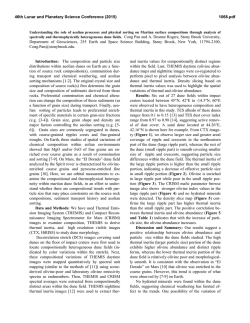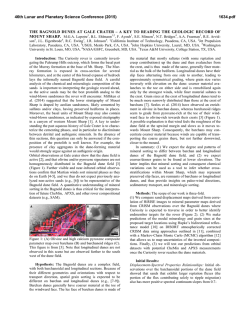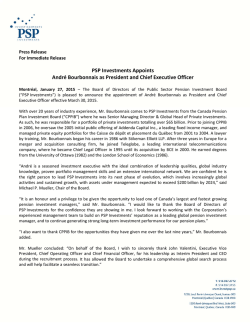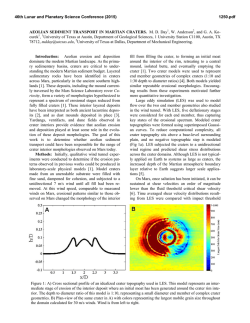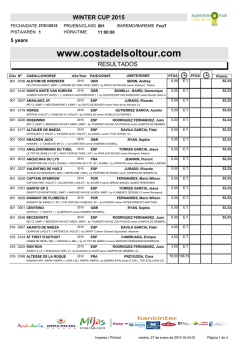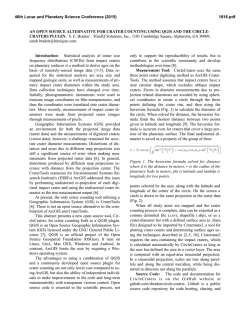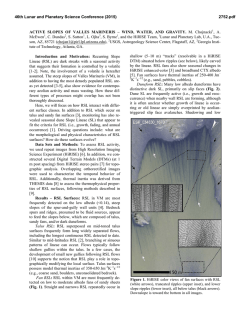
RIPPLE ORIENTATIONS AS AN INDICATION OF RECENT WINDS
46th Lunar and Planetary Science Conference (2015) 1539.pdf RIPPLE ORIENTATIONS AS AN INDICATION OF RECENT WINDS ON MARTIAN DUNES. M. B. Johnson1 and J. R. Zimbelman1, 1Center for Earth and Planetary Studies, MRC 315, National Air and Space Museum, Smithsonian Institution, Independence Avenue and 6th Street SW, Washington, DC 20013, [email protected]. Introduction: Sand dunes on both Earth and Mars have been shown to preserve the most recent wind patterns in their ripple formations [1, 2]. This investigation, supported by NASA MDAP grant NNX12AJ38G, continues the documentation of ripples on martian dunes in order to assess recent surface wind flow [3]. This information will provide insight into the modes of dune formation and ripple morphology, and offer current constraints for global circulation models. Background: Movement of martian sand ripples was first observed by the Spirit rover [4] and is now studied with images from the High Resolution Imaging Science Experiment (HiRISE) camera [5]. This instrument provides unprecedented views of Mars, including sand dunes in diverse areas with resolution as high as 25 cm/pixel [6]. Some dunes have complex structures and crest positions which may have been created by multiple wind directions or seasonal wind variations. Being unable to determine between multiple possible wind regimes leaves dune morphologies open to interpretation. However, dune crests and ripples mapped by Neilson and Kocurek show that the ripple-scale patterns are a better indicator of recent wind flow which modify the principle crests [1]. This same mapping technique can be used to document recent flows on Mars. Because wind speeds have yet to be measured directly in many areas, we must rely on high resolution images and ripple scale features for recent wind information. Methodology: Martian study sites in this investigation must have clear HiRISE frames and be able to represent diverse locations across the surface, decided primarily by their latitude and longitude. Frames with stereo pairs are preferred because of their ability to create digital terrain models (DTMs) with 3D modeling software such as SOCET SET. The resulting 30 frames studied to date are indicated in Table 1. The ripple documentation method for the first 7 images was the Java Mission-planning and Analysis for Remote Sensing (JMARS) geospatial information system (GIS) while the remaining images were studied using ESRI’s Arc GIS. In both systems, lines were drawn perpendicular to ripple crests across three adjacent ripples in order to document ripple wavelength from line length and inferred wind direction from azimuth (Figure 1). It is not possible to infer a unique wind direction from ripple orientation alone and therefore these inferred directions have a 180 degree ambiguity [7]. For example, a crest with North-South alignment may have been constructed by an Easterly, Westerly, or bi-directional wind. Due to this ambiguity, results presented in this study will assume azimuths to be between 0 and 180 degrees. Actual orientations may be defined after further study by using additional information about dune morphology, such as known dune types, and the rule of maximum gross bedform-normal transport [8]. Ripples in each study site are then categorized by the cardinal wind direction they suggest and percentages of each inferred direction are calculated. Percentages of wavelength values are also displayed in order to look for possible patterns. In some areas with DTMs, inferred wind direction is compared to the slope magnitude on which the ripple formed. This gives an idea of how great the effect of slope may be on ripple orientation by the process described by Howard [9]. Site Region 1 Hellespontus 2 Gale Crater 3 Nili Patera 4 North Polar 5 Aonia Terra 6 Lus Chasma 7 Arabia Terra 8 Terra Cimmeria 9 Lyot Crater 10 Icaria Planum Crater 11 South of Promethei Terra 12 Terra Sirenum 13 Vastitas Borealis 14 Milankovic Crater 15 Becquerel Crater 16 Terra Tyrrhena 17 Gamboa Crater 18 Aeolis Mensae 19 Wirtz Crater 20 Near Cerberus Fossae 21 Coprates Chasma 22 Kaiser Crater 23 North Polar 24 Syrtis Major Planum 25 West of Daedalia Planum 26 Herschel Crater 27 Capen Crater 28 South of Valles Marineris 29 Promethei Terra 30 Terra Sirenum HiRISE frame ID Lon E Lat PSP_007663_1350 38.779 -44.859 PSP_009571_1755 137.497 -4.463 ESP_017762_1890 67.321 8.779 PSP_010019_2635 118.543 83.505 ESP_013785_1300 293.1 -49.804 ESP_027341_1720 276.387 -7.718 ESP_016459_1830 4.553 3.12 ESP_025645_1455 138.437 -34.23 PSP_009746_2290 29.287 48.864 ESP_029478_1350 259.932 -44.482 ESP_022731_1080 143.002 -71.68 ESP_023928_1205 218.035 -59.098 ESP_018925_2520 344.658 71.906 ESP_018930_2350 213.42 54.576 PSP_001955_2015 351.899 21.445 ESP_026675_1655 97.769 -14.552 PSP_002721_2210 315.704 40.78 PSP_010178_1825 122.357 2.247 ESP_021603_1315 334.681 -48.256 PSP_008449_1885 169.194 8.566 ESP_026905_1660 296.894 -14.092 PSP_007110_1325 18.794 -46.98 ESP_027474_2610 223.471 80.832 ESP_019845_2000 79.425 19.823 ESP_024838_1630 207.988 -16.72 PSP_006974_1635 128.39 -16.391 ESP_026757_1865 13.958 6.349 ESP_025625_1580 320.382 -21.603 ESP_023285_1230 133.179 -56.923 ESP_023731_1405 195.967 -38.96 Table 1: Information for the 30 study sites where ripple measurements have been recorded to date. Sites are listed in order of completion. 46th Lunar and Planetary Science Conference (2015) Terra Sirenum Observations: One site explored in this study is in Terra Sirenum (HiRISE frame ESP_023928_1205), where 333 ripples were recorded and analyzed for dominant wind direction, emerging patterns of ripple wavelength, and effect of slope on ripple deflection. The percent of measurements in each each direction are as follows: 1% ESE-WNW wind, 36% SE-NW, 38% SSE-NNW, 24% S-N, and the remaining 1% SSW-NNE. This shows that the wind is likely from the SSE with additional ripples centered around this direction. The wavelengths varied from 2 to 4 meters and the distributions show that 3 to 4 meter wavelengths make up the majority of measurements in the ESE and SE while 2 to 3 meter wavelengths make up the majority of SSE, S, and SSW measurements. It is not yet clear whether there is a relationship between the two. The slope distribution shows that very few (about 5%) measurements were on slopes of larger than 15 degrees, which is not an adequate number for affirming significance. However, these measurements fell into two of the larger categories (SSE and S), which does not indicate a tendency toward anything other than the same distribution. Further investigation into one small dune in this frame (Figure 2) shows that while the angle between the direction of inferred wind and direction of maximum slope ranges between 13 and 87 degrees, the dune shape suggests NW-SE wind on the majority of the dune with some variation on the base of the eastern side, where form flow would occur. This indicates again that slope does not seem to have a large affect on ripple orientation and deflection. Figure 1: Ripple mapping of HiRISE frame ESP_025645_1455. Note that areas with clear ripple definition for tens of meters contain measurements while areas with overlapping patterns have been avoided. 1539.pdf Figure 2: Subscene of HiRISE frame ESP_023928_1205 with blue lines indicating ripple measurements and red lines indicating the direction of maximum slope. Results: This study has yielded several preliminary results. Firstly, the martian surface supports many dune types, including barchan and linear, in areas with adequate sand supply. The complexity of ripple patterns varies from uniform directionality for hundreds of kilometers to complex, overlapping patterns which create areas that cannot be documented by this process. These suggest the existence of multiple dominant, perhaps seasonally varying winds. The study of individual frames has indicated that there may be a relationship between wavelength and azimuth, though more study is needed. It has also suggested that slope angle does not have a significant effect on ripple formation with regards to orientation. The study of additional frames will expand our understanding of these relationships. References: [1] Neilson J. and Kocurek G. (1987) Geol. Soc. Am. Bull., 99, 177-186. [2] Ewing R. C. et al. (2010) J. Geophys. Res., 115, E8. [3] Zimbelman J. R. (2011) NSPIRES NNH11ZDA001N-MDAP. [4] Sullivan R. et al. (2008) J. Geophys. Res., 113, E6. [5] Bridges N. T. et al. (2012) Nature, 485, 339-342. [6] McEwen A. S. et al. (2007) J. Geophys. Res., 112, E5. [7] Sharp R. P. (1963) J. Geology, 71, 617-636. [8] Fenton, L. K. et al. (2014) Icarus, 230, 5-14. [9] Howard A. D. (1977) Geol. Soc. Am. Bull., 88, 853-856.
© Copyright 2026


